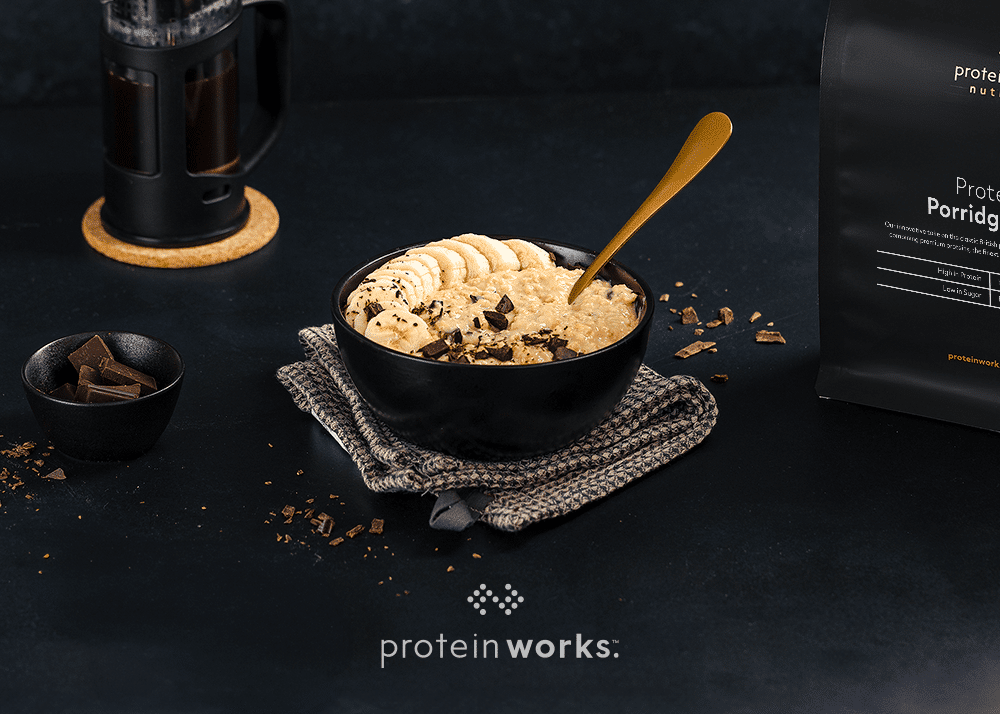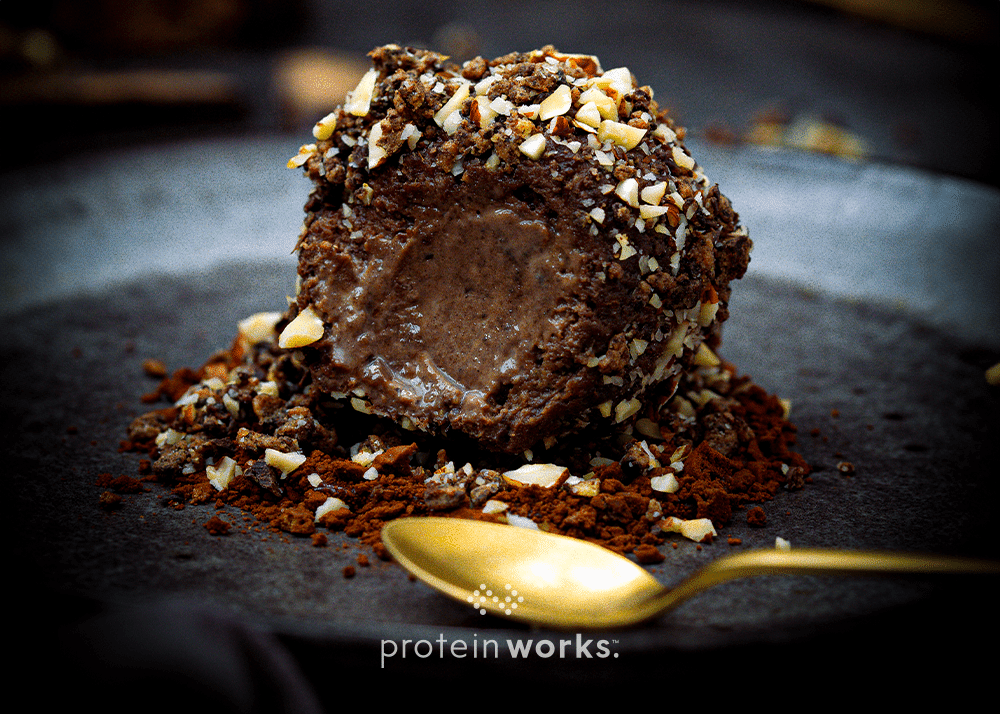
Top 6 High Protein Breakfast Ideas
We’ve got you covered here with our favourite high protein breakfast ideas this Autumn.
It’s Autumn, which means cosy nights and pumpkin spice. For some, however, as the temperature drops and the days fall shorter, autumn can also mean a dwindle in morning motivation, sometimes meaning breakfast is the first thing to go!
To prevent the often-touted most important meal of the day from slipping by, this blog offers six high protein breakfast recipes that are both comforting and nutrient-dense break. Each recipe will be sure to get you jumping out of bed in the morning with excitement, ready to break your fast the right way.
Why high protein?
Protein has a higher thermic effect than carbohydrates and fat, meaning that our bodies burn more energy to process it (1). Protein, therefore, can help keep us feeling fuller for longer, which can prevent snacking and overeating later in the day (2). Research suggests that evenly spacing out your protein intake over the day is optimal, especially if your goals are to build muscle (3-6). Whilst the daily recommended amount of protein can depend on personal goals, body weight, age and gender, and medical history, our body’s ability to uptake and utilise protein typically plateaus at around 20g for animal protein and 30g for plant-protein (7-9). This is why, each recipe that lies below have be crafted to contain 20-30g protein. We hope you enjoy, and be sure to adjust any ingredients to suit your dietary needs and preferences.
Here are our Top 6 High Protein Breakfast Ideas this autumn:
Pumpkin Pie Baked Pancake Bowl
Tis’ the season in which using pumpkin in almost everything is acceptable, so it is only right we kick off these high protein breakfast ideas with a classic.
Makes enough for 1
Ingredients:
- 55g Protein Works Milk Choc Chip Loaded Protein Pancake Mix
- 100g pumpkin puree
- 1/2 tsp cinnamon
- 1/4 tsp nutmeg
- 1/4 tsp ground cloves
- 150ml soya milk or milk of choice (more if desired, depending on consistency preference)
- Top with: ½ banana and Protein Works Only Peanuts Peanut Butter
Instructions:
- Pre-heat the oven to 180ºC, fan.
- Mix together the spices and milk.
- Add your pancake mix to a bowl, along with pumpkin puree and pour in the spiced milk. Mix until smooth.
- Pour the pancake mixture into a single-serve oven-safe dish and bake for roughly 20 minutes, or until cooked through the centre.
- Remove from the oven and allow to cool for a few minutes before adding your toppings.
Nutrition Spotlight:
Pumpkin – Potassium and magnesium rich
Oats – source of Beta-glucans and protein
Flaxseeds – source of fibre, protein, and omega-3 fatty acids
Vanilla Chai Protein Pancakes
Moist but fluffy, sweet and flavoursome. Made with a slightly peculiar ingredient, but one that will change your pancake game no doubt.
Serves 1
Ingredients
- 1/2 banana
- 70g oats or Protein Works Pure Fine Instant Oats
- 20g Protein Works vanilla protein powder
- 1 vanilla chai tea bag
- 150ml unsweetened almond or oat milk
- ½ tsp ground sweet cinnamon
- Pairs great with a topping of cashew butter
Optional extra: 1 scoop of Protein Works Creatine Monohydrate
Instructions
- Place the milk into a microwaveable mug. Microwave for two minutes & then stir in the tea bag, just as you would in tea, until the bag is completely drained and milk has turned a beautiful caramel colour.
- Place the vanilla milk, flour, protein, banana & cinnamon into a blender and blend until smooth.
- Heat up a frying pan on medium to high heat & neatly pour the mixture in mini circles or large one circle, depending on the size you want your pancakes to be.
- Wait a few minutes before flipping over. You will know it’s time when the edges of the pancakes begin to change colour slightly and the surface begins to bubble a little.
- Flip over and repeat the cooking time. Then transfer onto a plate and enjoy!
Nutrition Spotlight:
Banana – source of fibre, magnesium, potassium.
Chai tea – source of antioxidants
Cacao & Ginger Smoothie Bowl
Rich chocolate with hints of spicy ginger, undertones of almonds and a chocolate crunch. What screams fall more than this!
Serves: 1
Ingredients
- 1 banana
- 125ml unsweetened almond milk
- 20g Protein Works vanilla vegan protein powder*
- 1 tbsp (10g) cacao powder
- 15g smooth almond butter
- 1 thumb-sized knob of ginger, peeled and roughly chopped
- 1 pitted medjool date (optional)
- 1 tbsp cacao nibs
Optional extra: 1 scoop of Protein Works Creatine Monohydrate
*For a non-protein powder option, try swapping this for 100g of silken tofu and adding in ½ tsp of vanilla extract.
Instructions
- Place all the ingredients, apart from the cacao nibs, into a blender and blitz until smooth.
- Now add in the cacao nibs, and pulse to break up the nibs. This gives the smoothie a slight delicious bite and crunch.
Nutrition Spotlight:
Cacao powder and nibs – sources of magnesium, copper, potassium, iron, and zinc
Medjool dates – source of fibre, potassium, calcium, and a great natural sweetener.
Banana & Cinnamon Tofu French Toast
Serves: 1
Ingredients
- 100ml unsweetened almond or oat milk
- 1/2 tsp ground cinnamon (add a little extra if you want a stronger taste)
- 1/2 ripe banana
- 70g silken tofu
- 10g plant-based vanilla protein powder
- 2 slices of thick wholemeal sourdough bread
Optional extra: 1 scoop of Protein Works Creatine Monohydrate
Instructions
- Place all of the ingredients (except the bread) into a blender and blitz until smooth.
- Take your bread and with a fork, poke a couple of holes into the bread slices (this will help the mixture seep into the bread better).
- Transfer the mixture into a shallow dish and submerge the bread into the mixture and allow the bread to soak up the banana/tofu mixture for 5 minutes before turning them over to soak again on the other side.
- Lightly coat a frying pan with oil. Transition the soaked bread onto the frying pan, leaving them to cook per side for 5 minutes before flipping them over (if you try to flip them too soon, the mixture with just come away from the bread and stick to the pan).
- Serve on a plate with your choice of toppings.
Nutrition Spotlight
Silken Tofu – source of protein and magnesium
Wholemeal bread – source of fibre and protein
Warm Apple & Cinnamon Porridge / Overnight Oats
Porridge is a classic fall/winter breakfast staple, however you can also make this recipe into overnight oats too. In fact, soaking your oats overnight has been shown to increase the absorption of protein and minerals they contain! (10)
Think of this as getting two high protein breakfast ideas for your buck!
Serves: 1
Ingredients:
- 2 scoops (60g) Protein Works Apple & Cinnamon Protein Porridge
- 1 tbsp chia seeds
- 175ml – 200ml plant-based milk of choice
- A small handful of raisins
- 1 apple, diced
- 1 tbsp Protein Works Peanut Butter
- Spoonful of naturally sweetened granola (optional)
- Drizzle of syrup (optional)
Optional extra: 1 scoop of Protein Works Creatine Monohydrate
Instructions:
- In a large pot on medium to high heat, begin to cook the oats with milk and chia seeds until it reaches your desired consistency.
- Add in the raisins and stir, cooking for another 2-3 minutes.
- Remove from heat and serve in a bowl, topped with your diced apple, drizzle of peanut butter and sprinkle of granola and/or syrup
Nutrition Spotlight:
Chia seeds – Source of fibre, protein and Omega-3 Fatty Acids
Apple – source of flavanols and fibre
Scrambled Tofu
Serves: 4
Ingredients
- 70ml unsweetened almond or oat milk
- 1 tsp paprika
- 1 tsp garlic granules
- 1 tsp turmeric
- 4 tsp nutritional yeast
- 1 tsp miso paste
- 350g silken tofu
- 400g firm tofu
- Couple of handfuls of spinach
- Salt, pepper, and chilli flakes, to taste
Serving ideas: on sourdough bread and avocado, or with plant-based sausages and baked beans
Instructions
- Blend the first 7 ingredients together, until smooth. This will make your egg-sauce.
- Heat a frying pan up on medium heat and pour in the egg-sauce.
- Crumble your firm tofu up into small pieces with your hands and add to the pan. Mix to coat the crumbled tofu in your egg-sauce.
- Allow to cook for roughly 10 minutes, mixing every few minutes. The tofu scramble should start to thicken, crisp a little and be cooked right through.
- Once at this stage, throw in your spinach and let it wilt before removing it from the heat.
Nutrition Spotlight:
Firm tofu – source of protein and calcium (if using calcium-set tofu)
And that’s it for our favourite autumnal high protein breakfast ideas!
We hope you found something that you can add into your diet this fall. Although if not, we’ve got even more ideas for you! Check out our previous blog on some more classical high protein breakfast ideas, with over 20 ideas to choose from.
References
- Westerterp, K. R. (2004). Diet induced thermogenesis. Nutrition & Metabolism, 1(1), 1–5.
- Richter, J., Herzog, N., Janka, S., Baumann, T., Kistenmacher, A. and Oltmanns, K. M. (2020). Twice as high diet-induced thermogenesis after breakfast vs dinner on high-calorie as well as low-calorie meals. Journal of Clinical Endocrinology & Metabolism, 105(3), e211–21.
- Mamerow, M. M. et al. (2014). Dietary protein distribution positively influences 24-h muscle protein synthesis in healthy adults. Journal of Nutrition, 144(6), 876–80.
- Schoenfeld, B. J. and Aragon, A. A. (2018). How much protein can the body use in a single meal for muscle-building? Implications for daily protein distribution. Journal of the International Society of Sports Nutrition, 15(1), 1–6.
- Trommelen, J., Betz, M. W. and van Loon, L. J. (2019). The muscle protein synthetic response to meal ingestion following resistance-type exercise. Sports Medicine, 49(2), 185–97.
- Yasuda, J., Tomita, T., Arimitsu, T. and Fujita, S. (2020). Evenly distributed protein intake over 3 meals augments resistance exercise–induced muscle hypertrophy in healthy young men. Journal of Nutrition, 150(7), 1845–51.
- Wolfe R. The underappreciated role of muscle in health and disease. Am J Clin Nutr.. 2006;84(3):475-82.
- Witard O, Wardle S, Macnaughton L et al. Protein Considerations for Optimising Skeletal Muscle Mass in Healthy Young and Older Adults. Nutrients.. 2016;8(4):181.
- Macnaughton L, Wardle S, Witard O et al. The response of muscle protein synthesis following whole-body resistance exercise is greater following 40 g than 20 g of ingested whey protein. Physiol Rep.. 2016.
- Gupta, R. K., Gangoliya, S. S. and Singh, N. K. (2015). Reduction of phytic acid and enhancement of bioavailable micronutrients in food grains. Journal of Food Science and Technology, 52(2), 676–84.




